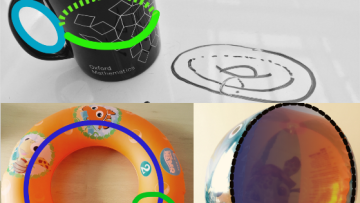17:00
17:00
Small-time fluctuations for sub-Riemannian diffusion loops
Abstract
We study the small-time fluctuations for diffusion processes which are conditioned by their initial and final positions and whose diffusivity has a sub-Riemannian structure. In the case where the endpoints agree, we discuss the convergence of the suitably rescaled fluctuations to a limiting diffusion loop, which is equal in law to the loop we obtain by taking the limiting process of the unconditioned rescaled diffusion processes and condition it to return to its starting point. The generator of the unconditioned limiting rescaled diffusion process can be described in terms of the original generator.
A life belt, a coffee cup, a jumping ball, a beach ball. What do these objects have in common? What sets them apart? Questions like these come under the mathematical umbrella of topology. And the theory of homology enables us to explore and understand them. Find out more in the latest in our Oxford Mathematics Alphabet.
The Loewner energy of chords in simply connected domain
Abstract
We study some features of the energy of a deterministic chordal Loewner chain, which is defined as the Dirichlet energy of its driving function in a very directional way. Using an interpretation of this energy as a large deviation rate function for SLE_k as k goes to 0, we show that the energy of a deterministic curve from one boundary point A of a simply connected domain D to another boundary point B, is equal to the energy of its time-reversal i.e. of the same curve but viewed as going from B to A in D. In particular it measures how far does the chord differ from the hyperbolic geodesic. I will also discuss the relation between the energy of the curve with its regularity, some questions are still open. If time allows, I will present the Loewner energy for loops on the Riemann sphere, and open questions related to it as well.
Log-concave density estimation
Abstract
The class of log-concave densities on $\mathbb{R}^d$ is a very natural infinite-dimensional generalisation of the class of Gaussian densities. I will show that it also allows the statistician to have the best of both the parametric and nonparametric worlds, in that one can obtain a fully automatic density estimator in the class (via maximum likelihood), with no tuning parameters to choose. I'll discuss its computation, methodological consequences and theoretical properties, and in particular very recent results on minimax rates of convergence and adaptation.
Rough path metrics on a Besov-Nikolskii type scale
Abstract
One of the central results in rough path theory is the local Lipschitz continuity of the solution map of a controlled differential equation called Ito-Lyons map. This continuity statement was obtained by T. Lyons in a q-variation resp. 1/q-Hölder type (rough path) metrics for any regularity 1/q>0. We extend this to a new class of Besov-Nikolskii type metrics with arbitrary regularity 1/q and integrability p, which particularly covers the aforementioned results as special cases. This talk is based on a joint work with Peter K. Friz.
Tail index estimation, concentration, adaptation...
Abstract
This paper presents an adaptive version of the Hill estimator based on Lespki’s model selection method. This simple data-driven index selection method is shown to satisfy an oracle inequality and is checked to achieve the lower bound recently derived by Carpentier and Kim. In order to establish the oracle inequality, we derive non-asymptotic variance bounds and concentration inequalities for Hill estimators. These concentration inequalities are derived from Talagrand’s concentration inequality for smooth functions of independent exponentially distributed random variables combined with three tools of Extreme Value Theory: the quantile transform, Karamata’s representation of slowly varying functions, and Rényi’s characterisation for the order statistics of exponential samples. The performance of this computationally and conceptually simple method is illustrated using Monte-Carlo simulations.
http://projecteuclid.org/euclid.ejs/1450456321 (joint work with Maud Thomas)
Mean field for interacting particles subject to environmental noise
Abstract
A system of interacting particles described by stochastic differential equations is considered. As opposed to the usual model, where the noise perturbations acting on different particles are independent, here the particles are subject to the same space-dependent noise, similar to the (no interacting) particles of the theory of diffusion of passive scalars. We prove a result of propagation of chaos and show that the limit PDE is stochastic and of in viscid type, as opposed to the case when independent noises drive the different particles. Moreover, we use this result to derive a mean field approximation of the stochastic Euler equations for the vorticity of an incompressible fluid.
Aspects of asymptotic expansions in fractional volatility models
Abstract
We revisit small-noise expansions in the spirit of Benarous, Baudoin-Ouyang, Deuschel-Friz-Jacquier-Violante for bivariate diffusions driven by fractional Brownian motions with different Hurst exponents. A particular focus is devoted to rough stochastic volatility models which have recently attracted considerable attention.
We derive suitable expansions (small-time, energy, tails) in these fractional stochastic volatility models and infer corresponding expansions for implied volatility. This sheds light (i) on the influence of the Hurst parameter in the time-decay of the smile and (ii) on the asymptotic behaviour of the tail of the smile, including higher orders.


